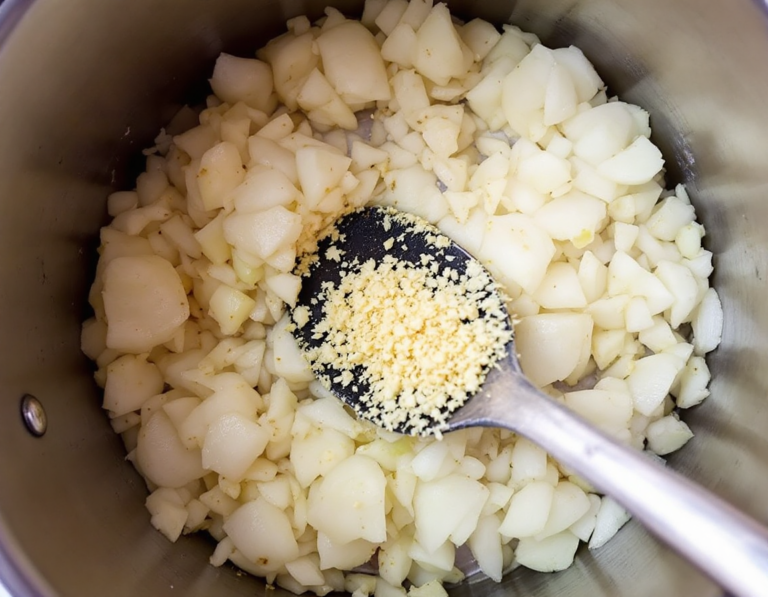
Get ready to savor a dish steeped in tradition and flavor. The Three Sisters Stew is a celebration of harmony, bringing together corn, beans, and squash in a delightful blend. This recipe not only warms the heart but also nourishes the soul, offering a comforting taste of heritage that has stood the test of time.
Steps
- In a small bowl, combine all the spice and herb ingredients, ensuring they are well mixed and then set the bowl aside for later use.
- In a large stock pot, sauté the diced onions over medium heat until they soften, which should take about 7 to 9 minutes. If the onions start sticking, add a small amount of vegetable broth or water to the pot.
- Stir in the minced garlic, continuing to cook for an additional minute while stirring constantly to prevent burning.
- Add the remaining base ingredients (except for the baking soda and butternut squash) and the spice/herb mix to the pot, bring to a boil. Stir in the baking soda, then reduce the heat to a simmer.
- Simmer the mixture for 10 minutes, then add the cubed butternut squash. Continue to simmer for another 15 to 20 minutes, or until the potatoes and squash are tender, stirring occasionally.
- Let the stew sit for 5 minutes to allow the flavors to blend. Remove and discard the bay leaf before serving. Enjoy the stew with flatbread for a complete meal.

Ingredients
- 1 medium yellow onion, finely diced
- 2 tablespoons minced garlic
- 2 cans (14.5 oz each) petite diced tomatoes
- 2 cups low-sodium vegetable broth
- 2 cups water
- 16 oz red-skinned potatoes, cubed and unpeeled
- 1 can (15 oz) kidney beans, drained and rinsed
- 1 can (15 oz) black-eyed peas, drained and rinsed
- 1 can (15 oz) corn, drained
- 1 package (9 oz) frozen cubed butternut squash
- ¼ teaspoon baking soda (optional)
- 1 teaspoon onion powder
- 1 teaspoon garlic powder
- 2 ½ teaspoons cumin
- 1 teaspoon mild chili powder
- ¼ + 1/8 teaspoon smoked paprika
- ½ to 1 ¼ teaspoons sea salt
- 1/8 teaspoon black pepper
- 1 bay leaf
- Flatbread
FAQ
- Can I use fresh butternut squash instead of frozen?
- Yes, fresh butternut squash can be used. However, it will require longer cooking time. It’s recommended to microwave, bake, or steam the fresh squash until tender before adding it to the stew towards the end of cooking to help it maintain its shape.
- What type of potatoes can I use in the stew?
- The recipe uses red-skinned potatoes, but you can also use peeled Russet potatoes, gold potatoes, or any general-purpose potatoes that are cubed.
- How can I adjust the seasoning in a low-fat, oil-free stew?
- For a dish that is oil-free and low-fat, it’s vital to taste the stew three times before adjusting seasonings. This helps you gauge the flavor build-up on the palate, ensuring you don’t over- or under-season it.
- Why is baking soda included in the recipe?
- Baking soda is used to neutralize the acidity from the tomatoes without losing their flavor. It causes the mixture to bubble initially and then settles down as it reduces the acidity. If you enjoy the ‘tinny’ flavor of canned tomatoes, you can skip the baking soda or use just a pinch.
- Can I freeze the Three Sisters Stew?
- Yes, the stew can be frozen for later use. Just ensure it’s stored in a suitable container for freezing.
Tips
- Taste Multiple Times: Since this is a low-fat and oil-free dish, flavors might not be as immediately pronounced. Taste the stew at least three times during cooking to ensure it’s seasoned to your liking, as the absence of oil can affect how flavors are perceived.
- Frozen vs. Fresh Butternut Squash: If you prefer a quicker cooking time, use frozen cubed butternut squash. However, if using fresh squash, pre-cook it by microwaving, baking, or steaming until tender, and add it toward the end of cooking to maintain its shape.
- Acidity Adjustment: If the stew’s acidity from tomatoes is too strong for your taste, consider adding a pinch of baking soda. This will neutralize some of the acidity while preserving the tomato flavor.
- Flavor Development: Allow the stew to rest for at least 5 minutes after cooking to let the flavors meld and intensify, enhancing the overall taste before serving.
Equipment
- Large Stock Pot – A must-have for preparing large quantities of stew or soup.
- Vegetable Chopper or Dicer – To assist with finely dicing onions and other vegetables efficiently.
- Garlic Press – To easily mince garlic.
- Bay Leaf Strainer – Useful for removing bay leaves from soups and stews.
- Spice Rack/Organizer – To keep the various spices and herbs organized and easily accessible.
